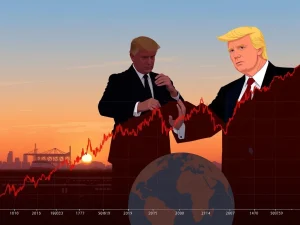Bitcoin Price: Unseen Macro Headwinds Powering the Rally, Not Just ETFs

Everyone’s talking about spot Bitcoin ETFs and their impact on the market, right? While those inflows are certainly significant, some analysts are pointing to a less discussed but potentially more powerful force driving the recent Bitcoin price rally: global macroeconomic shifts.
Understanding the Real Drivers: Macroeconomic Factors vs. ETFs
For months, the narrative has centered on institutional adoption via spot Bitcoin ETFs. However, independent market analyst Adam suggests that while ETF flows play a role, the primary engine behind Bitcoin’s recent gains is actually broader macroeconomic factors. These include rising inflation, volatility in the bond market, and geopolitical uncertainties like trade disputes.
Think about it: Bitcoin has seen a substantial rally since early in the year, coinciding with new tariffs being implemented. This timing reinforces the view that investors are increasingly looking at Bitcoin as a hedge against global instability, not just as a new investment product available through traditional channels.
Why Bond Market Stress Boosts Bitcoin’s Safe Haven Appeal
One key macroeconomic factor highlighted is the stress emerging in global bond markets. Historically seen as safe assets, government bonds are showing signs of vulnerability. For example:
- Long-term US Treasury yields have climbed.
- European 30-year interest rate swaps are rising, suggesting higher nominal growth and inflation expectations despite some central banks cutting rates.
- Japanese 30-year government bond yields recently increased amid concerns over the country’s high debt.
This environment makes investors question the long-term reliability of traditional sovereign debt. This is where Bitcoin comes in. As a non-sovereign, digitally scarce asset, it offers a stark contrast to traditional debt instruments facing inflationary pressures and increasing national debt burdens. This narrative strengthens Bitcoin’s position as a potential Bitcoin safe haven asset.
Connecting the Dots: Inflation, Rates, and the Bitcoin Rally
The current economic climate features central banks navigating persistent inflation while considering interest rate cuts. This creates a complex picture. In Europe, rate cuts are happening even as services inflation remains elevated. Markets interpret some of these moves as potentially fueling more vigorous economic activity and inflation down the line, rather than signaling a slowdown.
Rising long-term bond yields (bear steepening) also typically indicate markets pricing in stronger economic growth and inflation expectations. When combined with easy financial conditions (like those seen in the US), this encourages investors to take on more risk. Assets perceived as hedges against inflation or currency debasement, like Bitcoin, become more attractive in this scenario, contributing significantly to the ongoing Bitcoin rally.
Beyond ETFs: The Broader Macro Picture for Bitcoin
While the inflows into spot Bitcoin ETFs are tangible and easily tracked, they may represent a consequence of this larger macro shift rather than the sole cause of the price increase. The fundamental case for Bitcoin, according to some analysts, is now deeply rooted in these macroeconomic conditions.
Factors like rising global debt levels and the potential for further expansion of central bank balance sheets only add weight to the argument for non-sovereign, deflationary assets. Bitcoin is increasingly seen as a hedge not just against inflation but also against the potential instability in sovereign debt markets themselves.
This macro-driven narrative, coupled with expected significant investment inflows across the board (not just ETFs), suggests that these larger economic forces could continue to fuel capital flowing into BTC throughout the current market cycle.
Summary: Why Macro Matters for Bitcoin
In conclusion, while spot Bitcoin ETF flows are important, the recent surge in the Bitcoin price appears to be heavily influenced by significant global macroeconomic factors. Rising inflation, volatility and stress in the bond market, and geopolitical concerns are pushing investors towards assets perceived as safe havens. This environment strengthens the case for Bitcoin as a Bitcoin safe haven, positioning the current Bitcoin rally as fundamentally driven by these larger economic forces rather than solely by ETF investment vehicles. Understanding this broader context is key for anyone watching the crypto market today.








